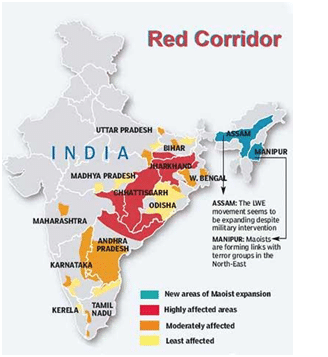Chhattisgarh Naxal Attack and Maoism in India
Context: Recently Ten personnel of the Chhattisgarh Police’s District Reserve Guard (DRG) and the civilian driver of their vehicle were reported killed in an IED attack by Maoists in the state’s Dantewada district.
Why have the Maoists carried out this attack in Chhattisgarh now?
- The timing of the attack fits with the Maoist strategy of heightened military activity and more attacks on security forces every summer. The CPI(Maoist) carries out Tactical Counter Offensive Campaigns (TCOCs) between February and June every year, in which the focus of its military wing is to inflict casualties on security forces.
- This period is chosen because with the onset of the monsoon in July, it becomes difficult to conduct offensive operations in the jungles. There are overflowing nullahs that can’t be crossed. There is tall grass and shrubs everywhere, which reduce visibility.
- Almost all major attacks by Maoists on security forces, including the 2010 Chintalnar massacre of 76 CRPF personnel, have taken place during the TCOC period.
- The TCOC period this year has been characterised by increasing IED attacks. Until April 15 this year, Maoists had carried out 34 IED attacks in Bastar, sources said. This figure was 28 for 2022 and 21 for 2021.
What is the current LWE situation in the country?
- The influence of Maoists and associated violence has been falling consistently in the country because of multiple factors, including a stronger push by security forces in Maoist strongholds, roads and civic amenities reaching the interiors to a greater extent than earlier, and a general disenchantment with the Maoist ideology among the youth, which has deprived the insurgent movement of new leadership.
- According to the government, Maoist violence in the country has gone down by 77% since 2010. The number of resultant deaths (security forces + civilians) has come down by 90 % from the all-time high of 1,005 in 2010 to 98 in 2022.
- The government has cut the number of districts declared to be Naxal-affected from over 200 in the early 2000s to just 90 now, and claims that the geographical spread of violence is actually restricted to just 45 districts.
- The presence of Naxals is said to be minimal to zero in Andhra Pradesh, Telangana, Odisha, Jharkhand, and Bihar, which were at one time their strongholds.
- According to the MHA, “the arc of violence has been considerably restricted with just 25 districts accounting for 90% of the LWE violence.”
- Budha Pahad, a 55 sq km forested area between Chhattisgarh and Jharkhand, considered to be the last bastion of Maoists in Jharkhand, had been freed of the insurgents.
What is the situation in Chhattisgarh?
- It is the only state in the country where Maoists continue to have a significant presence and retain the capability to mount big attacks.
- According to government data provided to Parliament, in the last five years (2018-22), 1,132 “violent incidents [were] perpetrated by Left Wing Extremists”, in which 168 security forces personnel and 335 civilians lost their lives. Chhattisgarh accounted for more than a third of all Maoist-related violence in this period — worryingly, however, it had a share of 70%-90% of deaths.
- The violence graph in the state for this period has been up and down. Maoists mounted 275 attacks in 2018; the number fell to 182 in 2019, but rose to 241 in 2020. It then declined to 188 in 2021, but rose to 246 in 2022. Until the end of February, Maoists had killed 17 people in the state this year, including seven security force personnel, in 37 attacks.
Why does Chhattisgarh continue to remain troubled?
- It is a widely accepted principle in counter-Maoist strategy that the war against Left Wing Extremism can only be won by the state police and not central forces. This is because the state police have local knowledge, understand the language, and have local networks that are essential for the generation of intelligence.
- It was through the active involvement of local police in the leading role that states such as Andhra Pradesh, West Bengal, Odisha and Jharkhand were able to end their Maoist problem.
- All these states formed special units of their police forces with personnel and officers drawn from the state, gave them special training, and won the battle with concerted security and development efforts.
- This process started late in Chhattisgarh. By this time, police of neighbouring states had pushed Maoists from their states to Chhattisgarh, making it a concentrated zone of Maoist influence.
- The absence of roads in the interiors of Bastar has stymied the operations of security forces. Minimal presence of the administration in the interiors of South Bastar has ensured that Maoists continue to have influence in the region and enjoy local support through a mix of fear and goodwill.
| Practice Question
1. What is the current LWE situation in the country? What are the steps taken by central and state governments to curb the menace?
|




